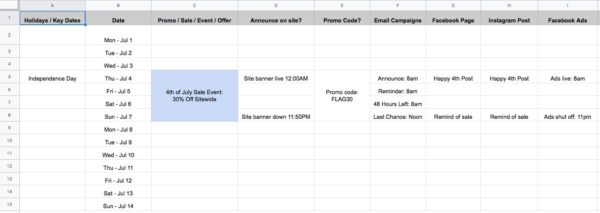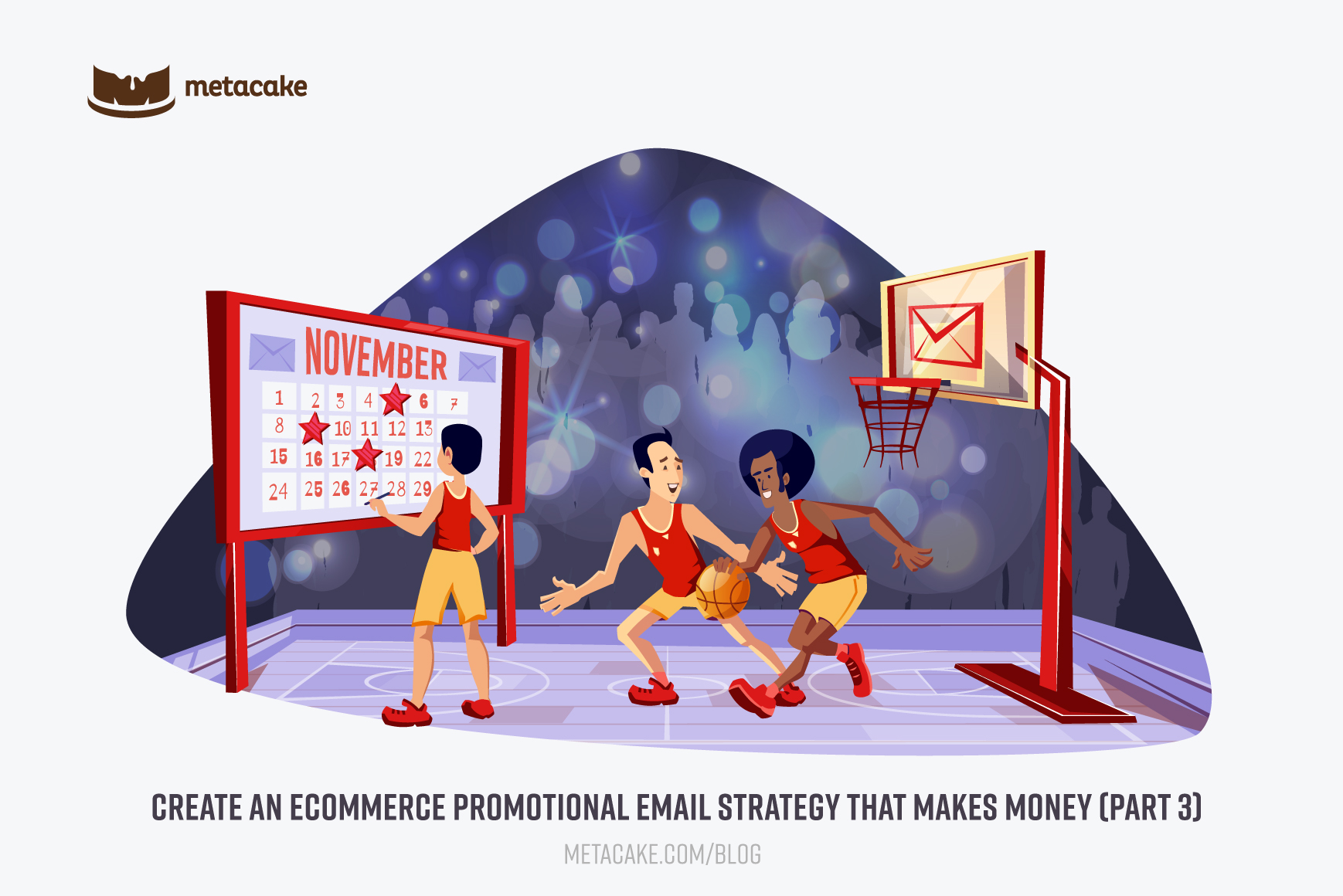
Create an Ecommerce Promotional Email Strategy that Makes Money (Part 3)
One of the most critical pieces of your ecommerce email program is, of course, your promotional campaign strategy. These emails are based on promotions, product releases, or content. They are one-off emails (not automated sequences) and they’re based on a predefined marketing calendar. That marketing calendar takes into account any holidays as well. Side note: promotional emails should also run in tandem with all other marketing channels, from Facebook advertising to Google Ads to your organic social posts. Whether you’re releasing a product or running a sale, if you are not synchronizing the message on all channels, you are missing out on a lot.
Your Secret Weapon: The Marketing Calendar
One of your secret weapons for email domination is something many brands choose to live without: a unified marketing calendar. If your company skips this step, you are missing out big time. Honestly, it amazes me how some of the biggest brands don’t have a marketing calendar for their year and rather run campaigns ad-hoc. If you do nothing else, create a marketing calendar!
When building your marketing calendar, sit down with leaders from all key areas of your business to plan for every notable event happening throughout the year. Of course, things might change from January to July, but all departments should be on the same page about what is planned month to month. As things change, you adjust. This includes events like: holidays, special promos, product releases, press events, or any other notable company events the public is interested in. If an email is going out, it should be on the calendar. If a sale is running, it should be on the calendar.
The Benefits of a Unified Marketing Calendar
A marketing calendar serves 2 basic purposes:
- It keeps everyone on the same page. There are no surprises, and all departments can coordinate to create the biggest impact from marketing teams to customer service teams.
- It allows the business leaders and stakeholders to plan the key events that will ultimately drive revenue for the year. Seeing everything laid out will identify holes and weaknesses very quickly.
If you’re trying to achieve a business goal (which you probably are) then you need a plan to get there.
Our Ecommerce Marketing Calendar Template
Once monthly events are in order, every channel involved in these promos needs to be added to the marketing calendar (see example below). We typically include columns for email marketing, each paid ad channel (Google, YouTube, Facebook), each social channel (Facebook, Instagram, etc.), traditional PR, your brand’s blog, and even your website. For each event, you will fill these columns with details about how the channels are involved. Take note of messaging to be used, emails built, ads planned, and times to activate ads.
We even made our template available for you to use:
Here’s our Marketing Calendar Google Sheet Template
This may sound like a lot of effort, but after years of coordinating marketing across multiple channels (and multiple brands), we can promise you it is worth it. It will keep your email strategy intentional and ensure it is properly aligned with all other marketing efforts, which is a powerful thing.
Types of Promotional Emails
Now that you have a calendar to keep everyone in sync, let’s talk specifically about the types of promotional emails you should be sending.
When planning these one-off email campaigns, there are three types that should be used for a complete strategy: new product announcements, sales or promotions, and content. Keep reading to dive into the details of each and check out a few examples below.
1. New Product Releases
When new products are released on your ecommerce store, you need to spread the word. Make these emails exciting and informative, selling the new product with vivid descriptive details. Find a concise way to explain why the customer should buy it, and create emotion that urges them to take action. If there is an interesting story or inspiration behind the product, share that as well.
As a general rule, we do not recommend discounting new products. You should focus on creating enough buzz around the new release that your customers are compelled to purchase because of how awesome it is, not because of its low price.
Here are some great product launch emails from our client, Groove Life to help inspire you.
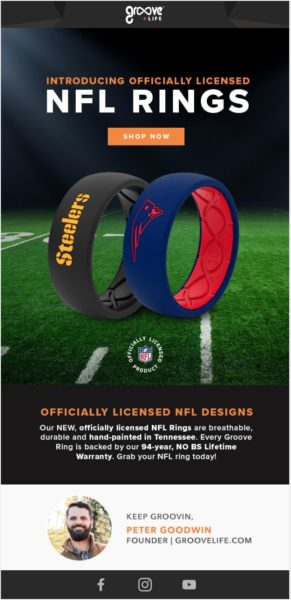
Example of Groove Life’s NFL Ring Launch Email

Example of Groove Life’s Nomad Product Launch Email
2. Sales Announcements & Reminders
Before running a sale, build anticipation by announcing the promotion ahead of time. Consider asking customers to subscribe to a pre-sale segment of your list to access exclusive deals or the latest updates. These subscribers will help you identify customers who are most interested in your promotions and are the most likely to become your brand super fans. Then use this pre-sale list to launch your sale with force.
Your work is not over once your sale announcement is sent! You need to send several reminder emails to follow up. Be careful to remind, but not annoy. For most major sales, we recommend the following schedule:
1 to 2 days prior to the sale:
- Pre-sale announcement
Launch day:
- 9am: Announce sale
- 7pm: Reminder of sale
- These are fully designed emails that articulate the discount or offer and when the sale ends. Always include products as well with links to the product pages or a sale collection. One great feature of Klaviyo is that you can drop a product grid directly into your email template.
2 days before sale ends:
- Reminder of just 48 hours left to save
Last day of the sale:
- Send a reminder for 24 hours left and/or 12 hours left
- You can also include a 3 hours left email as a last chance. We’ve found that using all text instead of graphics for these last minute reminders work very well.
Pro Tip: Don’t bombard your customers with emails after they make a purchase! Create a segment of names who have placed an order since the sale began and exclude them from each reminder email.
Here are some great examples of in-sale reminders for inspiration.

Example of In-Sale Reminder Email From Violette Field Threads
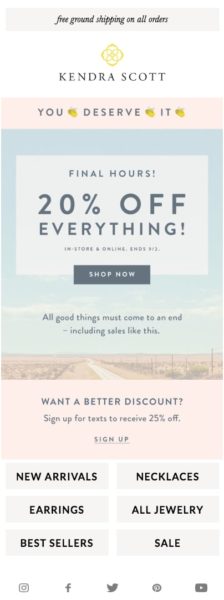
Example of In-Sale Reminder Email From Kendra Scott
3. Content-Driven Emails
In order to keep a balanced email strategy, it’s important to incorporate content-driven campaigns alongside the emails that push sales. This is a key part of developing customer relationships. Don’t avoid this type of email thinking you have nothing to say (because you do), or thinking that it’s not important because it isn’t “revenue generating”. You need to give as much as you ask.
Try sending emails that feature the top-selling products for the month, highlight customer reviews, or share customer stories. You could also provide tips for using your product, stories about the brand, or VIP exclusives. Overall, these types of emails are great for building relationships with your customers and often still bring in some revenue despite not pushing a hard sale.
Here are some great examples of content-rich emails for your inspiration from our friends at Wanderer Bracelets.
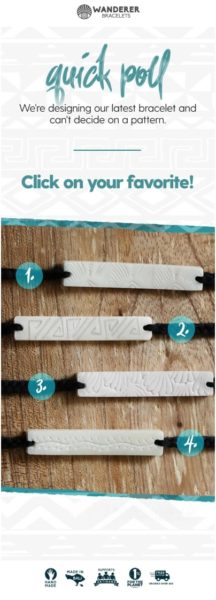
Example of a great content email from Wanderer Bracelet
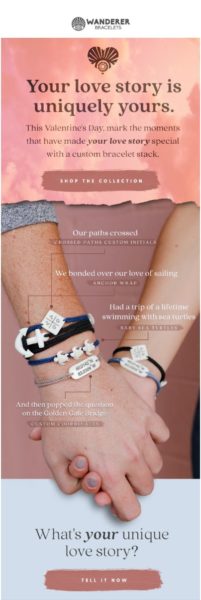
Example of a content/sale email from Wanderer Bracelet
Keeping Your List Healthy (and Happy!)
As we’ve outlined above, some sales or promotions call for more than one email. Even if there are several involved, there are ways to ensure you don’t burn out your list. Here are a few methods you should use consistently:
- As a rule of thumb, be sure that each email sent is adding value to the customer. If you have something new and valuable to say each time, it’s hard to lose.
- Have a well-planned list and marketing strategy for those customers. This will help create more effective and professional email marketing campaigns.
- Use Klaviyo’s smart send feature whenever possible. This keeps customers from getting emails if they’ve already received another email from you within the last 16 hours.
- Create a segment of customers who have purchased in the last week and exclude them from sale announcements. This will reduce the potential for customers to reach out and ask for a discount on a purchase they made last week, lightening your customer service team’s workload tremendously.
- As mentioned above, exclude sale purchasers from sale reminder emails for the duration of the sale.
What Indicates Success?
The main metrics to watch for promotional emails are engagement and revenue. Engagement is indicated by open rate, CTR, and shares (forwarding to others). For revenue, take a look at the total revenue driven by each email, as well as revenue per send.
Pro Tip: Pay attention to a few tell-tale warning signs to make sure you’re not overdoing it and burning out your list. High unsubscribe or spam rates, low sales, open rates or CTR, and (obviously) angry replies are indicators that you need to rethink your strategy.
For more info on measurement and metrics for success, refer back to part 2 of this series. And stick with us for the next part of this series, where we’ll reveal our number one tactic for generating email revenue while you sleep!
Want to be notified when the next post drops? Sign up for our Growth Academy Newsletter.

